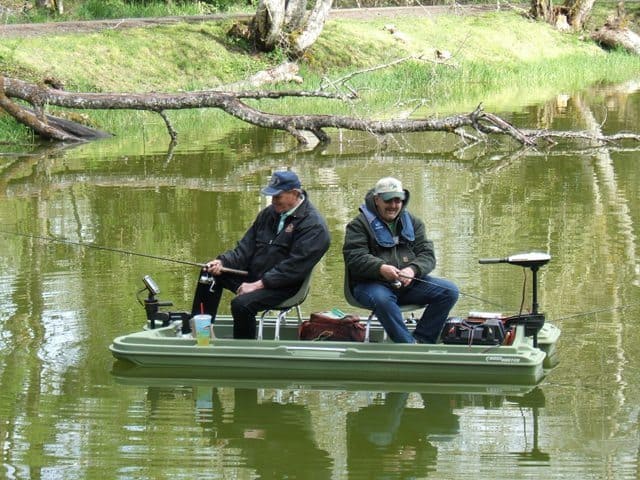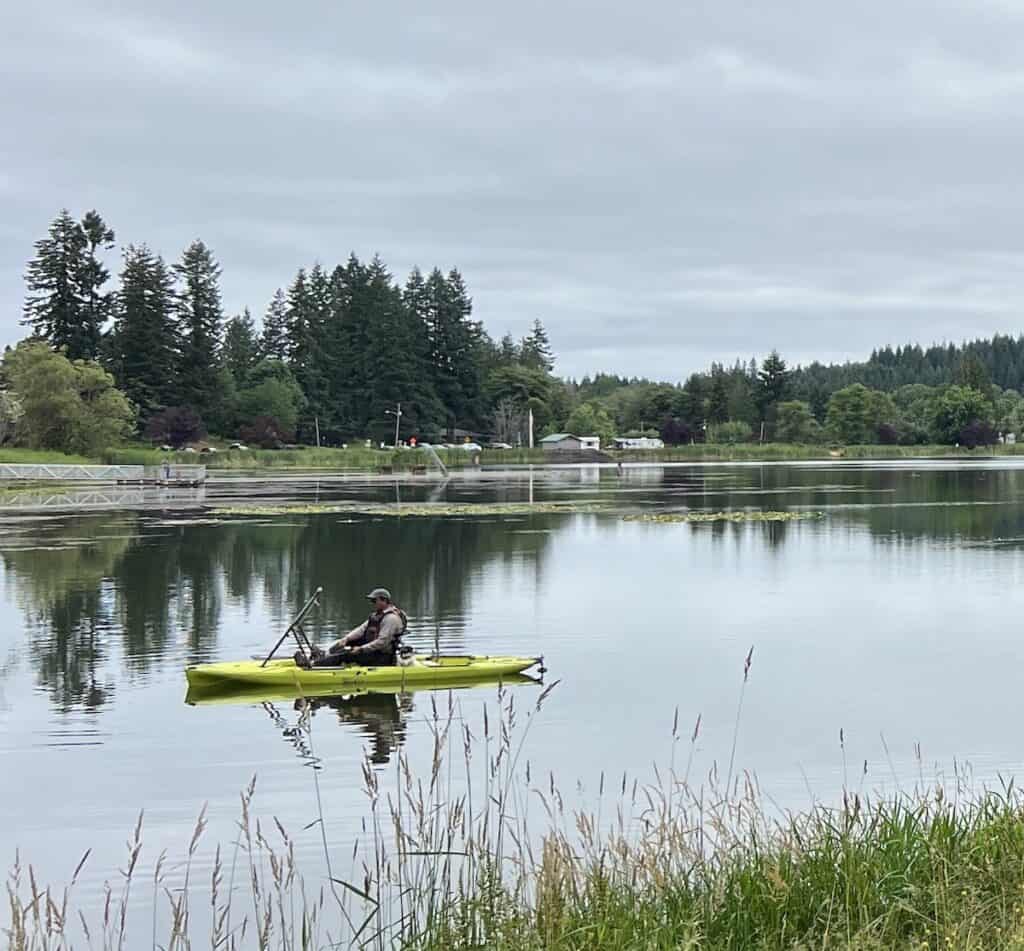Vernonia Lake is a great spot for anglers of all skill levels to catch a variety of fish, including rainbow trout, largemouth bass, crappie and other panfish.
Also known as Vernonia Pond, this 45-acre man-made reservoir sits right on the edge of the small city of Vernonia, a traditional logging town located in the forested hills of Columbia County northwest of Portland.
Access to this city park pond is as good as it gets for bank anglers, with a trail encircling the pond, with two fishing docks, a platform area, and plenty of other spots to reach the water to cast. It’s set up well for kids and people with disabilities.
You also can launch a small boat here from a gravel ramp near the parking lot, but no gas motors are allowed. It’s a great spot for a float tube, kayak or other small craft.
Trout Fishing
Fishing is especially popular here during the spring, when the Oregon Department of Fish and Wildlife stocks up to 10,000 hatchery-reared rainbow trout here over the course of a spring season.
Expect the first planting to come in about March, often ahead of Oregon’s Spring Break, and it’s likely ODFW will plan to stock it at least once or twice more by mid-spring.
Check out the bottom of this article for the current trout-stocking schedule. Trout fishing will be awesome for a few days after planting and then taper off until the next one.
Within a very short time of spilling down the stocking truck’s chute, these fish will aggressively bite bait, lures and flies.
Typical lake-fishing techniques will work here, with bait fishing always a popular approach. Berkley PowerBait is a favorite choice for many anglers because hatchery trout fall for it readily, but other jarred or natural baits, including nightcrawlers, will catch trout.
I like casting and retrieving spinners or spoons, which is a more active approach and also usually results in hooking fish right on the edge of the lip, so they are easy to release unharmed.
If you have a kayak, float tube or other similar craft, try slowly trolling a woolly bugger or similar sinking fly through the water. If it’s not getting down to the fish, pinch the smallest split shot weight you can to the line a few feet above the fly.
However, be cautious because Vernonia Pond is shallow, and emerging lily pads or other snags will snatch your fly, so keep it as shallow as you can and still catch trout.
For more information, see our article on Trout Fishing: Basic How-To Techniques and Tips.)
Note that lures and natural baits are also likely to catch the interest of the year-round fish residents in the lake, especially as warm-water species get increasingly active in the spring.
Trout fishing will taper off quickly after the last stocking of the year, with the combination of anglers (and ospreys) catching most of the fish and the warming water, making survival difficult for these cold-water species.
I would expect very few, if any, trout to be caught by June, and you can write off trout fishing altogether in this small lake by the hottest part of summer.
Bass Fishing
Springtime also is when the resident warm water fish go on the bite. They will continue to be active into the early part of the fall.
Largemouth bass are well-established here, although not present in huge numbers. Big fish are occasionally caught.
Fish around the lily pads and woody debris, focusing on the shallower water during the spring spawning period and sometimes in the early mornings and evenings during warm weather.
Bass will tend to hold in deeper water during hot weather and bright sunlight. Spinnerbaits, soft plastics, crankbaits and other lures will catch bass.
A weedless topwater lure such as a floating frog might just result in a blow-up of a strike you won’t soon forget.
We recommend releasing all bass here, as it’s a small pond and could easily become fished out of this larger and slower-growing predatory species.
Crappie Fishing
Crappie are schooling fish that also are very oriented to structure, and they may be found under the pond’s fishing docks, near dead tree limbs and along lily pad edges.
From shore, use a crappie jig under a bobber and cast out and jiggle it around likely looking cover or dangle the jig under the edges of the docks. Try to make that jig twitch like a small minnow.
Move around until you find a school of fish.
Bob Judkins, a crappie fishing expert with the Oregon Bass & Panfish Club, said a good place for bank anglers to start crappie fishing is at the dock to the left of the parking lot.
While the trout anglers cast out into the main lake, he turns around and fishes toward shore or in the shade of the dock. If the fish aren’t there that day, he just keeps working his way around the small lake.
Read Bob’s suggestions for the best crappie fishing tackle, which includes some fishing tips.
Both the bass and crappie here are subject to reduced harvest limits to keep this fishery viable.
Read the regulations before fishing and definitely don’t take more fish than you can eat, and it’s especially important to release large bass to maintain a trophy fishery because these are slow-growing fish.
Bluegill and Perch Fishing
This manmade lake is also home to other panfish species, most notably bluegill and yellow perch.
Both species often run small but are fun and easy to catch. They also are good-eating if you find some large enough to keep.
As with crappie, it’s usually a good idea to keep moving until you find biting fish.
Bluegill are often easy to catch with a piece of worm on a small hook fished beneath a bobber. Try casting near lilypads or other structures. They often can be found close to shore.
Yellow perch also are easy to catch on worms or other baits. They often are found in schools closer to the bottom, so once you find one, there are probably more.
Steelhead Fishing
Vernonia Lake is also one of a handful of northwest Oregon waters that will occasionally be planted with surplus hatchery steelhead during the winter.
This bonus fishery only happens when north coast hatcheries have more winter steelhead than they need to propagate the next generation of ocean-going rainbow trout.
Steelhead can be 5 to 10 pounds (or occasionally a little more) and put up a tremendous battle in a pond setting.
It might be a good idea to use 10-pound line and a larger rod and reel than you typically use for trout and bass. And bring a large net.
Steelhead will strike lures such as spinners and spoons that you cast and retrieve or wobbling or wiggling lures you can pull behind a small boat (no gas motors here).
Anglers also have some good luck fishing bait such as sand shrimp beneath a bobber.
You won’t find steelhead plantings in the annual trout-stocking schedule, but when they happen, they are typically reported in the ODFW’s weekly recreation report (see link below).
How to Get to Vernonia Lake
Vernonia Lake is just under an hour’s drive (about 45 miles) from much of the Portland area.
Take Highway 26 (Sunset Highway) west to Highway 47 and follow the signs north to Vernonia. You’ll pass through the main part of town and find the lake to your right, just off the highway.
From Highway 30 in the Scappoose and St. Helens areas, it takes a little over a half hour on the Scappoose-Vernonia Highway.
You can even get there by bike. Vernonia Lake’s trails are part of the Banks-Vernonia State Trail system in Columbia and Washington counties.
Vernonia has all of the basic supplies you’ll need for a day trip.
And while most anglers visit Vernonia Lake as a day trip, there are a literal handful of primitive and inexpensive campsites on the south side of the lake, close to the river.
Also, the city offers more developed camping at nearby Anderson and Vernonia parks, also both on the river.
Check the Vernonia Park Department for details.
A little farther north but still just about a 10-minute drive on Highway 47, Columbia County operates Big Eddy Park, on the banks of the Nehalem River.
2024 Vernonia Lake Trout Stocking
| Date Range | Total |
|---|---|
| Mar 18-22 | 2,500 |
| Apr 1-5 | 2,000 |
| Apr 29-May 3 | 5,500 |
Find more fishing spots in Clatsop County
Oregon Resources
ODFW Weekly Fishing Report
ODFW Trout Stocking Schedule
Oregon Fishing Regulations
National Weather Service


